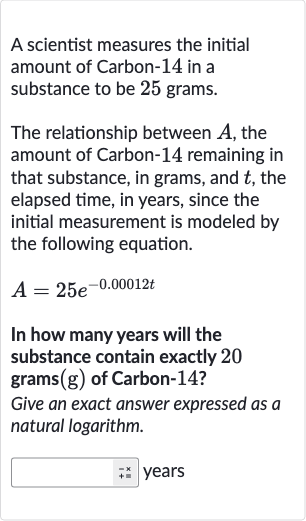AI tutor
Welcome to Bytelearn!
Let’s check out your problem:

A scientist measures the initial amount of Carbon in a substance to be grams.The relationship between , the amount of Carbon remaining in that substance, in grams, and , the elapsed time, in years, since the initial measurement is modeled by the following equation.In how many years will the substance contain exactly grams of Carbon?Give an exact answer expressed as a natural logarithm.years
Full solution
Q. A scientist measures the initial amount of Carbon in a substance to be grams.The relationship between , the amount of Carbon remaining in that substance, in grams, and , the elapsed time, in years, since the initial measurement is modeled by the following equation.In how many years will the substance contain exactly grams of Carbon?Give an exact answer expressed as a natural logarithm.years
- Set up equation: Set up the equation with the given amount of Carbon.We are given the equation and we want to find the value of when grams.So, we set up the equation: .
- Divide and isolate: Divide both sides of the equation by to isolate the exponential term.
- Take natural logarithm: Take the natural logarithm of both sides to solve for .Using the property of logarithms that , we get:
- Solve for t: Divide both sides by to solve for .
- Calculate value of : Calculate the value of using the natural logarithm.This is the exact answer expressed as a natural logarithm.
More problems from Convert between exponential and logarithmic form: all bases
QuestionGet tutor help
